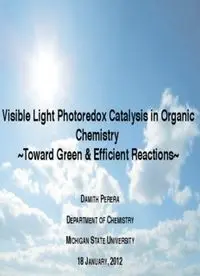
Visible Light Photoredox Catalysis in Organic Chemistry PDF
Preview Visible Light Photoredox Catalysis in Organic Chemistry
Visible Light Photoredox Catalysis in Organic Chemistry ~Toward Green & Efficient Reactions~ DAMITH PERERA DEPARTMENT OF CHEMISTRY MICHIGAN STATE UNIVERSITY 18 JANUARY, 2012 Photoredox Reaction: A Most Recent Example CN R3 N 26-W light source R2 N R3 + R2 N N Ir N R1 Ir(ppy)3 (0.5-1.0 %) R1 NaOAc, DMA CN CN 23oC, 12 h α-aryl amine Ir(ppy)3 “Discovery of an alpha-Amino C–H Arylation Reaction Using the Strategy of Accelerated Serendipity” McNally, A.; Prier, C. K.; MacMillan, D. W. C . Science 2011, 334, 1114-1117. Photoredox Reaction: A Most Recent Example CN R3 N 26-W light source R2 N R3 + R2 N N Ir N R1 Ir(ppy)3 (0.5-1.0 %) R1 NaOAc, DMA CN CN 23oC, 12 h α-aryl amine Ir(ppy)3 “Discovery of an alpha-Amino C–H Arylation Reaction Using the Strategy of Accelerated Serendipity” McNally, A.; Prier, C. K.; MacMillan, D. W. C . Science 2011, 334, 1114-1117. Serendipity • Serendipity: Fortunate Discoveries by Accident • Serendip, a former name for Sri Lanka + -ity. • In Science: “ It is true that my discovery of LSD was a chance discovery, but it was the outcome of planned experiments and these experiments took place in the framework of systematic pharmaceutical, chemical research. It could better be described as serendipity ” - A l b e r t H o f m a n n • D i s A c l o e v c x e i(Baarnertts Rosnenybeprg) d l e o a r f t i Fp n l e e n m i i c n i gl )l i n& ( http://en.wikipedia.org/wiki/Serendipity Accelerated Serendipity CN R3 26-W light source R2 N R3 + R2 N R1 Ir(ppy)3 (0.5-1.0 %) R1 NaOAc, DMA CN CN 23oC, 12 h α-aryl amine Choice of Catalysis: Photoredox Catalysis WhyP hotoredoxC ataylssi? Visible Light (43% of Solar Energy): Readily available, clean and renewable. An attractive “reagent” for organic synthesis • Potential byproducts are minimized • Atom economical • Mild alternative to traditional methods • Environmentally friendly Problem: Many organic molecules are unable to absorb v isible light requiring highly specialized energy sources for traditional photochemistry Solution: Photoredox catalysis For an early discussion of visible light in photochemical reactions see Ciamician, G. Science 1912, 36, 385–394. Why Photoredox Catalysis? “It is a relatively young and emerging field in organic synthesis that has recently delivered a variety of powerfu l bond-forming processes” -David MacMillan McNally, A.; Prier, C. K.; MacMillan, D. W. C. Science 2011, 334, 1114-1117. Basics of Photoredox Catalysis reductive oxidative 1 Ru2+ quenching quenching λmax 452 nm ViAorlo-NgOen2s ηisc = 1 (CEOt32N)2- Fe3+ Xanthate S2O82- 3 Ru2+ Ascorbate -0.83 V +0.84 V hν (PF6)2 φ = 0.04 tBu 2.12 eV hν tBu tBu N N N Ru N N tBu N Ru3+ Ru2+ Ru+ tBu strong strong +1.29 V -1.33 V tBu reductant oxidant 2+ Oxidative and Reductive quenching photoredox cycles of [Ru(bpy)3] Teply, F. Collect. Czech. Chem. Commun. 2011, 76, 859. Narayanam, J. M. R.; Stephenson, C. R. J. Chem. Soc. Rev. 2011, 40, 102. History of Photoredox Catalysis Kellogg O O EtOOC COOEt [Ru(bpy) 3]Cl2 S 1 mol% + Ph S+ BF4– + N CD3CN Ph 25 ºC, room light 0.3 h quantatitive 1978 1984 2003 2008 Hedstrand D. M., Kruizinga W. H., Kellogg R. M. Tetrahedron Lett. 1978, 19, 1255. History of Photoredox Catalysis Kellogg O O EtOOC COOEt [Ru(bpy) 3]Cl2 S 1 mol% + Ph S+ BF4– + N CD3CN Ph 25 ºC, room light 0.3 h quantatitive 1978 1984 2003 2008 COOH COOH hν λ > 410 nm [Ru(bpy)3]Cl2 5 mol% Deronzier N 2+ CH 3CN BF4– R R R= H, Br or OMe quantatitive Cano-Yelo H., Deronzier A. J. Chem. Soc., Perkin Trans. 2 1984, 1093.
